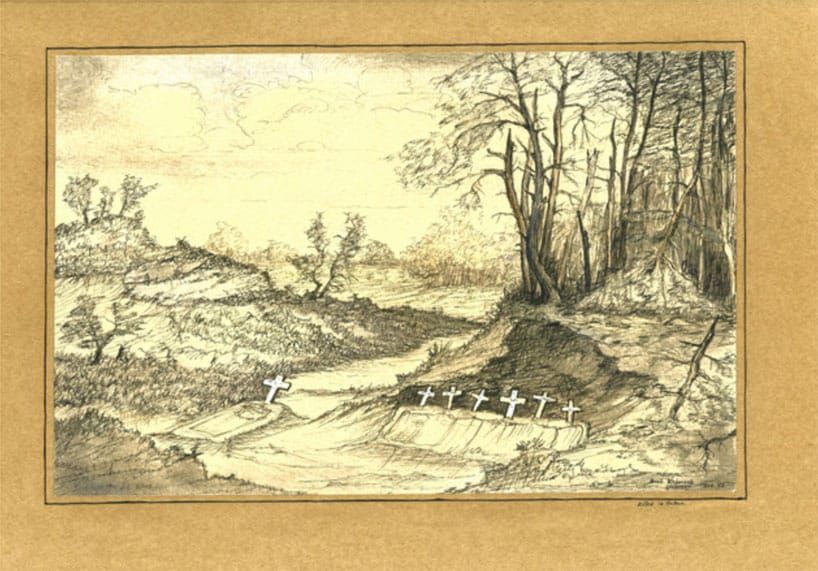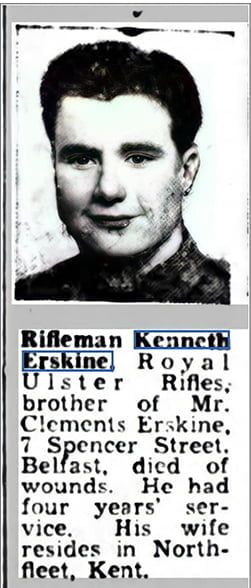Erskine | Kenneth
- First names
Kenneth
- Age
22
- Date of birth
1922
- Date of death
14-10-1944
- Service number
7020024
- Rank
Rifleman
- Regiment
Royal Ulster Rifles, 2nd Bn.
- Grave number
IV. D. 11.


Biography
Kenneth Erskine died of wounds on 14 October 1944 near Overloon. He was 22 years old and was a Rifleman in the 2nd Battalion of the Royal Ulster Rifles (Service Number 7020024). He was initially buried at Helderse Bossen Cemetery, Overloon, and on 29 May 1947, he was reburied in grave IV. D. 11 at the CWGC Cemetery in Overloon.
Family background
He had three brothers and one sister: Clements Hamilton Erskine (1921–1998), Henri Erskine (1924–1991), Cecil Erskine (1925–1941) and Doris Erskine Kielty (1926–1988). They were born in Belfast and lived there.
Kenneth’s father died in 1929 when Kenneth was only five years old.
His mother Sarah married Charles Mulholland a year later and had five more children with him: Walter Mulholland (1931-) Charles Mulholland (1931-2007) James Mulholland (1934-1950) and Annie Mulholland Hamilton (1936-2021) and Sarah Freeburn Mulholland (1940-1991). Three half brothers and two half sisters of Kenneth.
Kenneth married Agnes Elizabeth Wood of Worth, Kent, in Chatham Kent in April 1943.
The Belfast Blitz
Unfortunately, Kenneth’s mother and younger brother were killed in the Belfast Blitz on 16 April 1941. The Belfast Blitz was a series of devastating air raids carried out by the German Luftwaffe on Northern Ireland during the Second World War. The bombs caused widespread destruction and claimed many lives, affecting people of all religions and political backgrounds.
The Luftwaffe targeted sites of industrial and military importance across the city. However, it was the residents of the crowded working-class districts who suffered the most. In North and East Belfast, tightly packed and poorly built houses stood no chance against high-explosive bombs, parachute mines, and incendiaries.
Between 7 April and 6 May 1941, an estimated 900 to 1,000 people were killed in Belfast and in parts of Counties Down and Londonderry.
The heaviest attack came on the night of 15–16 April 1941, known as the Easter Raid. That night alone, between 600 and 700 people lost their lives. Among the victims were Sarah Mulholland Erskine, mother of Kenneth, and his brother Cecil.
Military career
It is not known exactly when he enlisted in the army and joined the Royal Ulster Rifles, but it seems to have been at the beginning of the war.
The 2nd battalion of the Royal Ulster Rifles took part in the D-Day landings in June 1944 and fought in the Battle of Normandy, specifically in Operation Charnwood where they were the first British troops to enter the city of Caen, which had previously seen bitter fighting in the British attempt to capture it.
From mid July until mid September they remained in France, alternating between spells of fighting and spells of rest and training. However, while at Troarn in France on 27 July, it was reported that shelling in the early morning had caused four casualties. A Casualty Report indicated that Rifleman W. Lewis of the Royal Ulster Rifles had been wounded but was remaining at duty. He will have been promoted to Lance Corporal at some point after this time.
On 16 September they made the long journey from their last base in France at Hacqueville to Naast near Soignes in Belgium. The War Diary states that “from Albert to Mons people lined the streets of the towns giving us a very warm welcome and presented us with fruit. In some places the crowds which congregated made it rather difficult for the convoy to get through”. They moved on a further 112 miles the following day to Kolis near Lille St Hubert. Again “cheering crowds welcomed us in every town and village, presenting us with coffee and more fruit.”
On 18 and 19 September the Battalion was involved in extending and solidifying the bridgehead over the Escaut Canal which had already been made by 50 Division.
On 21 September, they crossed from Belgium into the Netherlands at Maarheeze, where they rested until the 24th before moving on to Deurne on the 15th, Bakel on the 29th, Beers on 1 October and then Cuijk on 2 October. They remained in the vicinity of Cuijk until 11 October, experiencing some shelling but also undertaking training and relaxation. The War Diary reports that “The Battalion football team played a local Eleven at Beers, our team gaining an easy victory by 5 goals to 1. The game was watched by a large number of spectators & the Band was loudly applauded when they played during the interval & after the game.” During this period there was much mention of rain and wind.
Read here the detailed story about 8 october 1944, the day of the match, told after the war by the son of Sergeant Reginald Hammersley who played along and survived the war himself.
On 12 October, the Battalion moved about 10 miles south of Cuijk to Haps, St Hubert and Wanroij to near St Anthonis. It was decided that the 3rd British Infantry Division, of which the Battalion was a part, would clear the area of woody country as far as Venray and possibly further. The role of the Battalion was to lead the Brigade with the intention of capturing & clearing the large wood to the south west of Overloon. The following day they therefore marched from St Anthonis southwards and the initiative started at 0900 hrs. They had a few casualties crossing the open ground but had more cover once in the wood. However, the wood presented its own problems as it varied in thickness, tracks through it were soft and sandy and the tracks and woods on the map bore little relation to tracks and woods on the ground. Most of the enemy had, however, left the wood and they reached their intended position by 1800 hrs. Tanks had been unable to help as they could not follow the infantry through the wood. Indeed, no vehicles could reach the forward companies because tracks had not been cleared of mines so food, water, blankets & greatcoats had to manhandled up to the company positions by relays of working parties. They also had to dig in – so little sleep was had that night. Casualties during the day had not been heavy and these few were caused principally by mortar fire.
On 14 October, the Battalion stayed in position while the 2 Lincolns passed through and carried out an attack on woods 500yds to the south. Much of the day was spent pulling trucks out of the sand which had been bogged on the move of the previous evening. The forward Companies were able to return in small numbers at a time to the furthest point that the transport could reach which saved manhandling the food forward.
Under cover of darkness that night A&C Companies moved down the wood to assist the Lincolns in holding it during the night & following day. Unfortunately just as A coy were entering this wood a dead salvo from a Nebelwerfer landed right amongst them. It killed 2 men and wounded 10 more.
Together with six of his comrades, he was temporarily buried in the Helderse Bossen and reburied on 29 May 1947 at Overloon War Cemetery.
The other comrades were: Albert Victor Bushell, John Irvine, Melvern Roy Guy, William Henry Lewis, Richard Scott, and Wil van der Burgt.
Sources and credits
Sue Reynolds for the photo of Kenneth
Belfastblitz.com
Ancestry Civil and parish birth, marriage and death records and family trees.
This biography was compiled by our Foundation based on our own research and stories from other soldiers who served in the same regiment or participated in the same battle on that day. Part of the collective work within the Foundation was used for this purpose.
Research Anny Huberts



